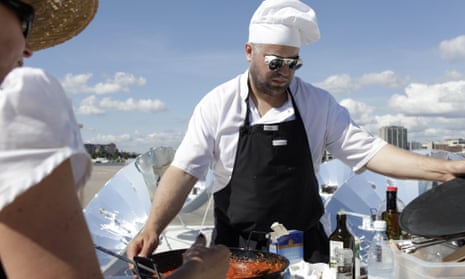Sunlight is the most abundant renewable energy source on earth and humans have found some ingenious ways to harvest it into food, warmth, and power. A recent report from the International Energy Agency found that by 2050 the sun could be the largest source of electricity, ahead of fossil fuels, wind, hydro and nuclear.
The decreasing cost of photovoltaic cells has also made the prospect of solar electricity going mainstream more realistic. And recent innovations have fine-tuned solar technology, making it more efficient, cheap and eco-friendly. Along with a team in Australia which has developed solar ink cells that can be printed on to plastic, and Mercedes-Benz which has unveiled a car coated in solar paint, here are six innovations that show the range of possibilities for using sunlight.
Cradle to cradle solar panels
Solar panels are usually considered a clean way of generating power, and this development makes them even more sustainable. The world’s first and only Cradle to Cradle (C2C) certified solar panels were launched last month by the US-based SunPower Corporation. All panels produced at its plant in Mexicali, Mexico, have achieved the silver level award, which requires proof of a fully sustainable manufacturing process.
C2C is a set of principles that measures product quality in terms of material health, material reuse, renewable energy, water stewardship and social fairness. SunPower does not use cadmium chloride or cadmium chemicals, which are known to be harmful and are used in some solar panels. The company has a reuse and recycling programme to deal with panels at the end of their life and ensure that parts that can’t be reused are handled by certified recyclers.

“We wanted to help our customers make their homes as environmentally sustainable as possible. Our products are now fully recyclable and we use geothermal and other forms of renewable energy to make them. In order to get the award, we had to make sure all our suppliers use materials with a low risk of toxicity so they can be recycled safely,” says SunPower’s chief operating officer Marty Neese.
Concentrated solar power
A team at the University of California, San Diego, have developed a new nanoparticle paint that makes concentrated solar power (CSP) plants work more efficiently.
CSP uses mirrors and heat to generate electricity within sunny regions. Hundreds of thousands of mirrors direct sunlight to a tower where molten salt gets so hot it produces steam, driving a turbine and generating electricity. Unlike photovoltaic technology, CSP works when it’s cloudy or dark.
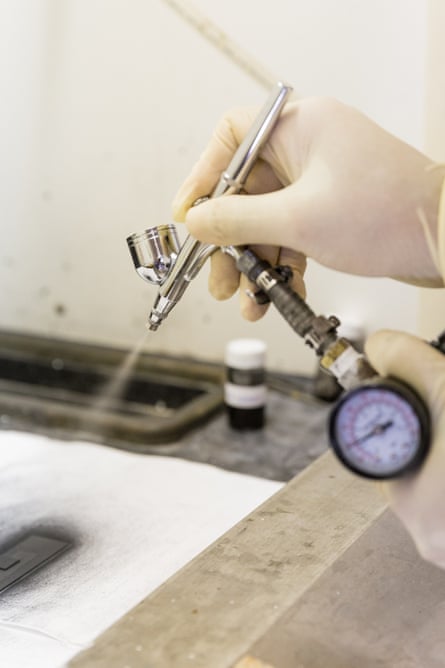
The nanoparticle paint absorbs and converts to heat more than 90% of the sunlight it captures and can withstand temperatures of over 700C. This addresses one of the main difficulties of CSP – the short lifespan of solar receivers in the tower due to heat damage. “We wanted to create a material that absorbs sunlight that doesn’t let any of it escape. We want the black hole of sunlight,” says Professor Sungho Jin from University of California San Diego’s Jacobs School of Engineering.
SolarLeaf
An apartment block in Hamburg is the world’s first to use sunlight to make heat and fuel using algae. The BIQ house has a photobioreactor façade known as SolarLeaf, developed by Colt International and SSC Ltd and designed by Arup engineers and Splitterwerk architects. The photobioreactor is a series of glass panels containing living micro-algae plants, which are supplied with nutrients, as well as CO2 which is produced on site. The algae absorbs daylight and CO2, photosynthesises, and generates heat of 40C that warms the building. The algae is later harvested and fermented to make biogas fuel to provide power and heat. As the algae expands in sunlight, it also shades the building during sunny periods.
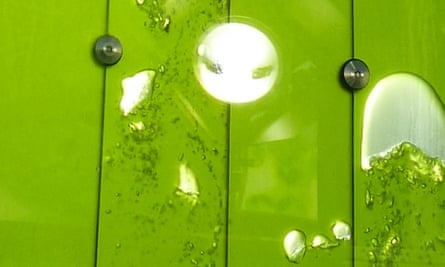
Dr Jan Wurm, Arup’s Europe research leader, explains: “The SolarLeaf biofacade is a way of storing solar energy to use as fuel later. It’s a pilot project with data being collected on energy production and usage until mid 2015.” Feedback from the residents of the 15 flats has been positive. Some have reported how calming it is to sit on the balcony and watch the bubbles rising.
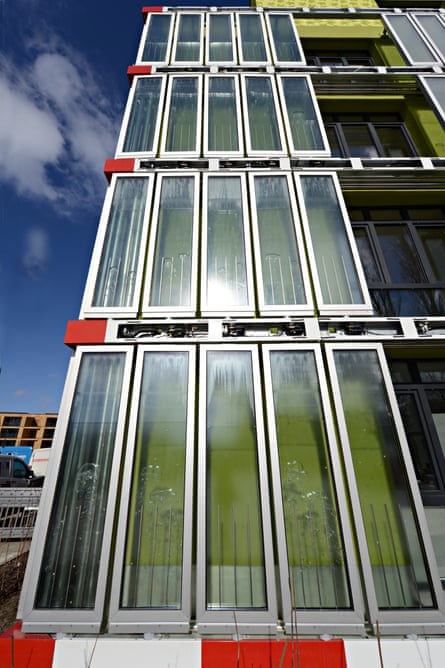
Solar restaurant
A solar cooker works by concentrating the suns rays in a large metal parabola, creating a hotspot warm enough to cook food. The device is not new but Finnish chef Antto Melasniemi and Catalan designer Marti Guixe have taken it to a new level with an entire restaurant run on pure solar energy. For the past four years, they have taken their outdoor solar kitchen (with up to 12 solar cookers) across Europe, creating pop-up restaurants. The project finished in Leeds in September 2014 where Melasniemi picked up a British Street Food Award.
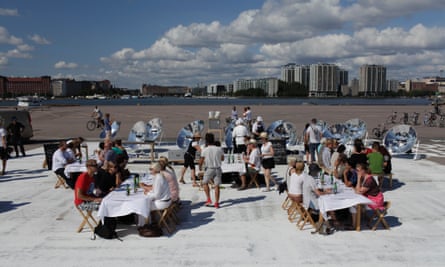
Solar cooking is not just for hot countries in summer; Melasniemi produced meals in snow-bound Helsinki in temperatures of -15 celsius. “Traditional restaurants try to control and exploit nature. In our kitchen, nature is controlling the restaurant. The concept tests people’s flexibility” explains Melasniemi. Guixe adds: “We did it as an experiment, but it is completely realistic to have a restaurant based on the sun.”
Solarbox
Two London-based social entrepreneurs are turning some of London’s iconic red phone boxes into charging points for mobile phones. The first green phone box, known as a Solarbox, was launched last month in London’s busy Tottenham Court Road area, and 10 more will follow by April 2015. The project’s founders are London School of Economics 2014 graduates Harold Craston and Kirsty Kenney, who came second in the Mayor of London’s Low Carbon Entrepreneur of the Year Award.
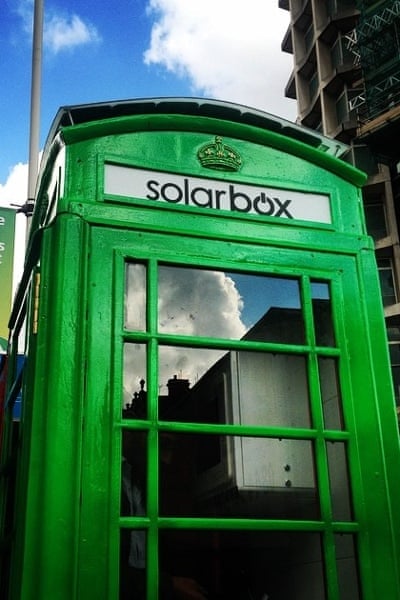
The solarbox has a 150W Solbian flexible solar panel mounted on its roof that connects to a USB phone charger inside. Phone charging is free to the public, funded by adverts that play while people wait. A month after it launched, the Solarbox is seeing an average of 80 users per day. Visitors generally spend between five and 10 minutes charging, suggesting a boost rather than a full charge. “The fact that solar panels have come down in price has helped make a project like this possible,” says Craston. “It’s also a great way of reclaiming public space.”
The Current Table
Designer Marjan van Aubel, a graduate of London’s Royal College of Art, has created an elegant piece of furniture that charges phones.
During the day the orange glass Current Table turns indoor light into electricity, storing it in hidden batteries. When the batteries are full, phones are plugged into USB ports and they charge at the normal speed.
The design was made possible by the development of dye-sensitised solar cells produced by Solaronix. They work by copying the process of photosynthesis in plants, using colour to harness the sun’s energy. The advantage is that they work indoors, unlike classic solar cells which require direct sunlight. “The bigger the surface you have the more efficient it is. It’s best to avoid piling stuff on top while the batteries are charging. So it encourages people to keep a clear and tidy surface, which is another benefit” van Aubel explains. The project is getting close to the production stage – so we may soon see Current Tables in boardrooms, restaurants and libraries.
Solar water disinfection
This is not strictly speaking a technological innovation but it is a brilliant way of saving lives. The sun’s ability to kill bacteria has been known about for more than 30 years. Solar water disinfection (SODIS) involves simply putting water into transparent plastic bottles and leaving them in the sun for up to 48 hours. The combination of heat and UV rays from the sun kill bacteria, so even if the water is still brown it is safe to drink.

A team led by Professor McGuigan of the Royal College of Surgeons of Ireland, and including Dr Jacent Asiimwe and Dr Rosemary Nalwanga, has been spreading knowledge about the process in the Lwengo district in south-west Uganda for the past four years. They have been researching the use of the SODIS method in schools, in the home and in the community.
“SODIS really has proved to be a cost effective method of providing safe drinking water for communities in African countries,” says Professor Mcguigan. “The next step is to get wider buy-in from various communities in Uganda and other African countries where people do not have access to safe drinking water.”
Alice Grahame is a freelance journalist with an interest in sustainability and innovation. Follow her @alicesangle
Read more stories like this:
- Drawing back the panel: which solar companies are most (and least) sustainable?
- Hacking the optimal office space
- Brought to you by BT: Cutting emissions and saving money through teleconferencing
The technology and innovation hub is funded by BT. All content is editorially independent except for pieces labelled “brought to you by”. Find out more here.
Join the community of sustainability professionals and experts. Become a GSB member to get more stories like this direct to your inbox
